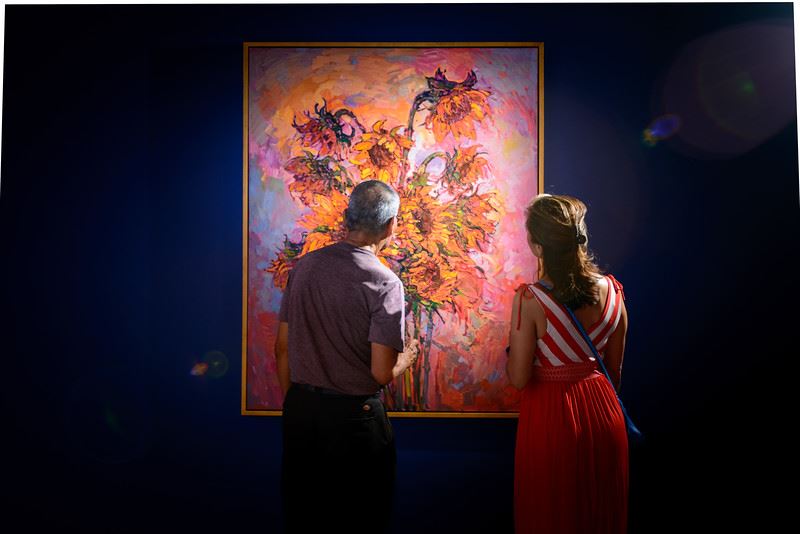Subtotal
$0
U.S. Shipping
FREE
Saved for Later
Shopping Cart
Subtotal
$0
U.S. Shipping
FREE
Saved for Later
Art is oft considered to be both an investment and, more often than not, something one feels deeply about. This can create a struggle when choosing which paintings or artists to select for your collection. You may love a piece, but wonder if it is worth the price. You may be weighing the best investment between favored pieces or artists because you are simply running out of room. The pointers below are here to help you work through this conflict and find the right art for your taste – and your pocketbook.
 Find Out if the Artist Garners Respect in His Field
Find Out if the Artist Garners Respect in His Field
One of the simplest ways to find out what a piece of art is worth is to discover what other people feel about the artist. Is he or she considered “up and coming” or "established"? Do other artists, collectors and curators respect the works created by this artist? This can often be detectable by how many establishments showcase their work, how many shows they have done, a consistency in or an increasing number of exhibitions, and what kinds of media outlets or publications have covered their exhibitions or collections.
Respect and popularity are fundamentally subjective concepts. Senior to external opinions or even financially staticized evidence would be your "gut" instincts. Art trends will transition, so sometimes your "natural desire" will prove to be a better guide than raw facts and figures.
Career Trajectory
Whether you are shopping for art online, at fairs, at museums exhibitions, or in galleries, with some simple sleuth work you can detect a semblance of a path in every artist’s career.
Speak with the artist, look online and consider how driven they are. Do they seek out additional representation? Can you find them? Do they prefer to solely focus on painting and in that case, do they have any kind of support system?
Many artists or representing galleries list a partial or complete portfolio on their website, and it may be worth taking a look to see if their paintings appear to be selling over time. Another telling indicator is if the artist exhibits his works actively in museums, galleries or fairs / festivals. You can also take a look at their numbers of followers on social media sites. Tens of thousands of followers on Facebook, with hundreds more adding every week, may be an indicator of growing popularity.

Exhibition Pieces and Unique Exploration
Another consideration when choosing a painting for your collection is the uniqueness of the piece. It may be interesting to note if the painting, sculpture or photograph in which you are interested is a prime example of a period in the artist’s work or of a particular style the artist is exploring. By understanding the artist more completely, you can make a smart and interesting purchase which will likely increase in value over the years.
You may also find that the piece you are considering purchasing is a singular example of the artist’s newest trajectory or exploration.
Generally it is recommended to get an exhibition catalogue or similar where possible, this can be kept with a COA (certificate of authenticity) and provenance.
One noted tactic is to collect works of an up-and-coming, talented and driven artist early in his career. By doing this you are not only bringing pieces you love into your collection but you are actively participating in a century’s old angel investment program. Your interest and exhibition of the artist’s work may be the launching point needed to take the artist’s career from relatively unknown to enormously popular.
Only Collect Pieces You Truly Love
Investing in art that you personally love keeps the human element in your investment. If you are purchasing a piece that you actually don’t like solely because it seems popular right now, then it likely will not hold up to the price you are paying. A truth in most investments is that values fluctuate, and more often than not, in the artworld, the greatest value will not be seen in any one lifetime.

Talk to the Artist – and to Other Collectors
One of the simplest ways to discover if an artist is worth your time and money is to discuss their work with them, with collectors, and with museum curators. The internet makes it easier than ever to research artists, look at their careers, and talk with them. Use these tools to your advantage!
As a note, many galleries or artists websites now include videos, multiple images and many more creative ways to fully showcase the work in its entirety. The ease of purchasing artwork halfway around the world will only increase in the years to come.
Article by Julia Shaw.
Discover the artist at the forefront of modern impressionism.

About Erin
ERIN HANSON has been painting in oils since she was 8 years old. As a teenager, she apprenticed at a mural studio where she worked on 40-foot-long paintings while selling art commissions on the side. After being told it was too hard to make a living as an artist, she got her degree in Bioengineering from UC Berkeley. Afterward, Erin became a rock climber at Red Rock Canyon, Nevada. Inspired by the colorful scenery she was climbing, she decided to return to her love of painting and create one new painting every week.
She has stuck to that decision, becoming one of the most prolific artists in history, with over 3,000 oil paintings sold to eager collectors. Erin Hanson’s style is known as "Open Impressionism" and is taught in art schools worldwide. With millions of followers, Hanson has become an iconic, driving force in the rebirth of impressionism, inspiring thousands of other artists to pick up the brush.